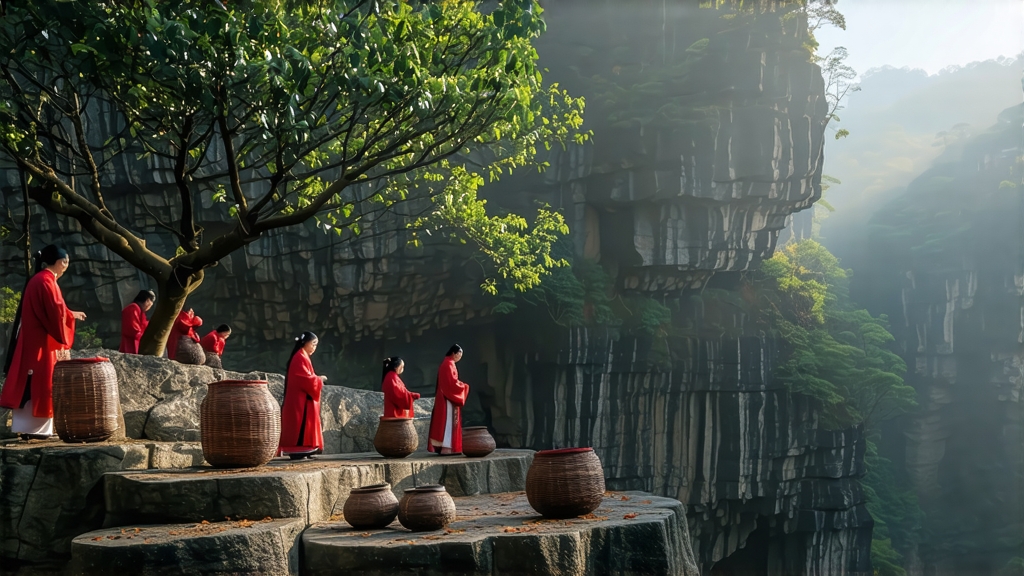
Wuyi Da Hong Pao—literally “Big Red Robe”—is the most storied sub-variety of Chinese oolong, a tea whose very name evokes imperial legend, vertiginous cliffs, and the taste of liquid stone. First recorded in the early Ming dynasty (14th c.), it is grown inside the 60-km² Wuyi Mountain core reserve of northern Fujian, a UNESCO dual heritage site where 36 peaks, 99 valleys, and a riverine microclimate create the “rock rhyme” (yanyun) that connoisseurs prize above all other flavors in tea. Of the hundreds of oolongs produced in China, only the teas picked within this basalt canyon earn the coveted prefix “Zheng Yan,” meaning “true cliff,” and Da Hong Pao is their undisputed monarch.
Three interlocking meanings of the name Da Hong Pao are still debated in the tea mountains. The romantic version tells of a Ming scholar who cured the emperor’s mother with tea cut from six bushes clinging to Tianxin Rock; the emperor sent crimson imperial robes to drape the bushes in gratitude. A second, pragmatic reading claims the red glaze of roasted leaf resembled the vermilion robes of court officials. A third, botanical explanation points to the young shoot’s crimson hue each April. Whatever the truth, the mythic aura has never faded: in 2005, 20 g of mother-tree tea auctioned for ¥208,000 (US $25,000), an event that catapulted rock oolong onto global luxury menus.
Today, the market distinguishes four distinct Da Hong Pao categories. Mother-Tree DHP, plucked from the three remaining 350-year-old bushes on Jiulongke cliff, has been legally off-limits since 2006; even the Chinese state reserves the annual 200 g yield for diplomatic gifts. Pure-variety DHP, propagated by cuttings from those mother trees (now cloned as the Beidou or Qidan cultivar), represents less than 0.3 % of production and is reserved for collectors. Blended Zheng Yan DHP, the summit of everyday drinking, marries leaves from thirty-plus indigenous Wuyi cultivars—Rougui, Shui Xian, Tie Luo Han, Bai Ji Guan—whose combined fragrance is calibrated to echo the mother-tree profile. Finally, “commodity” DHP from outside the scenic zone uses the same cultivars but grows in alluvial soil, yielding a softer, less mineral cup; it is still legally labeled “Wuyi Rock Oolong,” but insiders call it “Zhou Cha,” or peripheral tea.
Crafting Da Hong Pao is a month-long choreography of stress and rest that begins in late April when the mountain air smells of ginger lilies and wet granite. Leaves are picked at 30–40 % oxidation, the ideal window for preserving green freshness while developing oolong’s trademark amber. Pickers climb bamboo ladders lashed to cliff faces, plucking only the central three leaves plus the bud, a standard called “kai mian.” The harvest must reach the village workshop within two hours; any delay triggers enzymatic browning that flattens the coveted rock rhyme.
Withering happens in three waves: first under late-morning sun for 15–20 minutes to soften cell walls, then on raised bamboo trays in a draughty corridor where mountain breeze lowers leaf temperature to 22 °C, and finally indoors under 60–70 % relative humidity where leaflets are tossed every half hour to bruise edges. This bruising is the kinetic signature of oolong: ruptured cells allow polyphenols to meet polyphenol oxidase, initiating partial oxidation that turns leaf rims reddish-brown while keeping the center jade green. Masters judge readiness by the sound—rustling like silk taffeta—and the aroma shift from cut grass to ripe peach and narcissus.
Kill-green follows at 240 °C for 3–4 minutes in a tilted wok fired with local hardwood; the goal is to freeze oxidation at 35–40 % while locking in floral notes. Rolling is still done barefoot on rattan mats: the master kneels, pressing leaf bundles into tight cords that will later unfurl like miniature scrolls. A 90-minute low-temperature bake (80 °C) dries the leaf to 8 % moisture, but this is only the prelude to the defining Wuyi craft—charcoal roasting.
Rock oolong is double- or triple-roasted over a